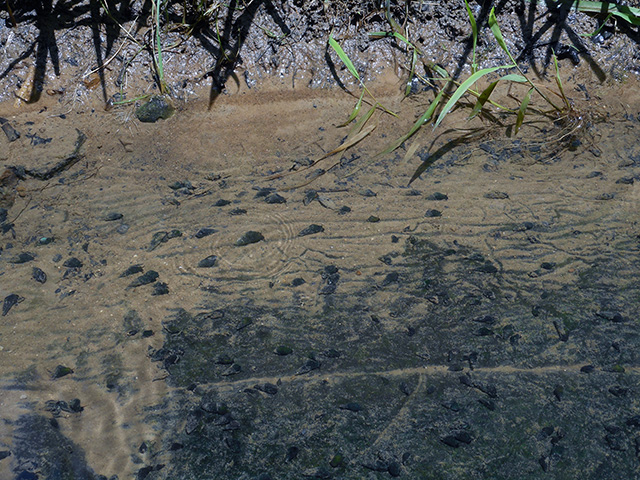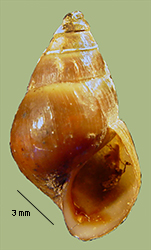Goniobasis or Elimia livescens
> Habitat & Distribution
The range of P. semicarinata livescens was mapped by Dazo (1965) as extending from eastern Wisconsin and Illinois across Michigan, southern Ontario, northern Indiana and northern Ohio to western Pennsylvania, New York and Vermont. He gave its habitat as "almost any clean and permanent type of freshwater environment (springs, swift flowing streams, inland lakes), usually found crawling on rocks and stones."
Populations inhabiting creeks and smaller rivers from southern Indiana and southern Ohio through Kentucky to the Cumberland drainage of Tennessee bear more slender shells and are here referred to as Pleurocera semicarinata semicarinata (Say 1829). Those inhabiting large rivers tend to be more robustly-shelled, and are here referred to as P. semicarinata obovata (Say, 1829). The FWGNA incidence rank calculated for all three subspecies together, across a range extending from Vermont to Wisconsin and Tennessee into Ontario, is I-5.
> Ecology & Life History
Dazo (1965) reported that mating takes place in the fall and egglaying April to August in his Michigan populations, with eggs laid singly, in short rows, approximately 4/day. Eggs hatch in two weeks, with laboratory growth to approximately 3.8 mm in year one and to 7 mm in year two, at which time maturity is gained. The laboratory-reared sex ratio was approximately 5 females:1 male. Dazo estimated a "normal life span" of 3 - 4 years for adults in his populations of P. semicarinata livescens, with annual iteroparous reproduction. This is life cycle Hi of Dillon (2000: 156 - 162), typical of pleurocerids generally.
Mancini (1978) reported egglaying from March to July in the population of P. semicarinata semicarinata he studied from southern Indiana, each female laying a (remarkably small) average total of just 43 eggs per season, each egg of a remakably small size. Maturation seemed to require 18 months, as was the case in Michigan, females apparently mating in their second fall and laying their first eggs two years after their own birth. Reproduction is annual and iteroparous thereafter, with a life span Mancini estimated to be 3 - 5 years. This confirms the Hi life cycle reported by Dazo in Michigan. Mancini reported a sex ratio in the field, sampled biweekly throughout the year, as 61 female:39 male.
Payne (1979) reported that three years were required for maturity in two New York populations of P. semicarinata livescens, life cycle pattern T. Dillon's (2000: 126 - 135) reanalysis of the bioenergetic data published by Payne (1979) showed that New York livescens populations demonstrate an order of magnitude lower reproductive effort than might be predicted from their mean adult body weight. This suggests that they are S-adapted, tolerant of a poor habitat that is nevertheless permanent and predictable.
Grazing by populations of pleurocerids can have a significant effect on energy flow in small streams (Dillon 2000: 86 - 91, see also Dillon & Davis 1991). Dazo reported that his Michigan populations of P. semicarinata livescens fed on "red and green algae, desmids and diatoms." The Douglas Lake livescens population inhabits shallower depths and sandier bottoms than any of the local pulmonate species (Lamen et al. 1984), and demonstrates a reduced grazing efficiency (Barnese et al. 1990).
Huehner and Etges (1977) reported the development of the trematode Aspidogaster conchicola - typically considered a bivalve parasite - in an Ohio population of "Goniobasis livescens."
> Taxonomy & Systematics
As is typical for most North American pleurocerids, variability in the shell morphology of P. semicarinata has led to a great number of synonyms. Dunithan and colleagues (2012) reported a gradual transition in the shell form of Pleurocera populations inhabiting the streams of Indiana, from those identified as semicarinata in the south (Goodrich & van der Schalie 1944) to those identified as livescens in the north. A similar transition can be observed elsewhere throughout the Midwest, correlated roughly with the glacial maximum. Dunithan and colleagues suggested that this phenomenon might be an ecophenotypic response to current or substrate, the more lotic southern environments yielding the typical semicarinata phenotype, the more lentic northern environments the livescens phenotype.
More recently Cazenave and Zanatta (2016) reported a correlation between the shape of shells borne by populations of Pleurocera semicarinata livescens on the shoreline of Lake Michigan and smaller inland lakes; the snails inhabiting higher-energy environments tending to bear more globose shells. The authors suggested that the larger-apertured, more globose morphology might be a response to the increased likelihood of dislodgement in exposed environments due to wave action.
Dillon's (2014) survey of gene frequencies at 11 allozyme-encoding loci confirmed the speculation of Dunithan et al., extending the results to populations bearing the extremely shell phenotype previously identified as "Lithasia obovata," lowering both livescens and obovata to subspecific status under semicarinata. More information about this surprising discovery is available from my essay of 11July14, link below.
Hybridization between P. semicarinata livescens and a Hudson River population of P. virginica through the Erie Canal has been reported by Bianchi et al (1994). Such a remarkable phenomenon, generalized across a variety of species and regions, suggests reticulate evolution in the North American Pleuroceidae. See my essay of 12Nov24 from the link below for more.
See Dazo's (1965) paper for marvelously detailed anatomical drawings, notes, and observations on the muscular, digestive, reproductive, circulatory, and nervous systems of Pleurocera semicarinata livescens. His inability to document any significant anatomical difference between what was at that time called Goniobasis livescens and Pleurocera canaliculata acuta in any respect was crucial in the subsequent unification of the two genera by Dillon (2011). See my essay of 23Mar11 from the link below for more.
The karyotype of P. semicarinata livescens sampled from Dazo's (1965) Toma Road Bridge site is 2N = 36 (Dillon 1991). Given the conservative nature of chromosomal evolution in the Pleuroceridae, there is no reason to expect that the karyotypes of typical P. semicarinata semicarinata or P. semicarinata obovata would be any different.
> Maps and Supplementary Resources
- Distribution of the three subspecies in the drainage of The Ohio (2019)
- Pleurocera semicarinata in Harrison Creek, central Kentucky. Click for high-resolution image.

- Photomontage comparing male and female P. semicarinata, highlighting the egglaying groove. Courtesy of T. Travis Brown.

> Essays
- Taxonomic controversy has surrounded the generic nomina Pleurocera, Goniobasis, and Elimia for many years. The best entry into the subject would be my essay of 23Mar11, entitled Goodbye Goniobasis, Farewell Elimia. Links are available from that essay to older resources.
- The concept of the subspecies, as that term is applied in the FWGNA Project, was elaborated in a pair of companion essays I posted in early 2014, "What is a Subspecies?" and "What Subspecies Are Not."
- On 11July14 I posted an essay elaborating the results of my (2014) paper on cryptic phenotypic plasticity in P. semicarinata, entitled "Elimia livescens and Lithasia obovata are Pleurocera semicarinata." That essay also includes a couple additional figures of extreme shell morphologies.
- In my essay of 12Nov24 I reviewed what is known about hybridization between P. semicarinata and P. virginica through the Erie Canal, and speculated about hybridization between P. semicarinata and P. simplex as well. Such results, carried through the diverse pleurocerid fauna of the interior drainages, suggest Reticulate evolution in the North American Pleuroceridae.
- The conspecific relationship between populations of P. semicarinata bearing shells of the typical form and heavily-shelled populations of the subspecies obovata was confirmed by the phylogenomic study of Whelan et al (2022). See my essay of 23Sept25, Anchored hybrid enrichment, Pleurocerid evolution, and the obovata confirmation.
> References
Barnese, L., R. Lowe and R.D. Hunter (1990) Comparative grazing efficiency of pulmonate and prosobranch snails. JNABS 9: 35 - 44.
Bianchi, T. S., G. M. Davis, and D. Strayer 1994. An apparent hybrid zone between freshwater gastropod species Elimia livescens and E. virginica (Gastropoda: Pleuroceridae). Am. Malac. Bull. 11: 73 - 78.
Cazenave, K.R. & D. T. Zanatta (2016) Environmental drivers of shell shape in a freshwater gastropod from small and large lakes. Freshwater Science 35: 948-957.
Dazo, B. C. (1965) The morphology and natural history of Pleurocera acuta and Goniobasis livescens (Gastropoda: Cerithiacea: Pleuroceridae). Malacologia 3: 1 - 80.
Dillon, R. T., Jr. (1989) Karyotypic evolution in pleurocerid snails: I. Genomic DNA estimated byflow cytometry. Malacologia, 31: 197-203.
Dillon, R.T. (1991) Karyotypic evolution in pleurocerid snails. II. Pleurocera, Goniobasis, and Juga. Malacologia 33: 339-344. Dillon, R. T. Jr. (2000) The Ecology of Freshwater Molluscs. Cambridge, Cambridge University Press. 509 pp.
Dillon, R. T. Jr. (2011) Robust shell phenotype is a local response to stream size in the genus Pleurocera (Rafinesque, 1818). Malacologia 53: 265-277. [pdf]
Dillon, R. T. Jr. (2014) Cryptic phenotypic plasticity in populations of the North American freshwater gastropod, Pleurocera semicarinata. Zool. Stud. 53:31. [pdf]
Dillon, R. T. Jr., & K. B. Davis (1991) The diatoms ingested by freshwater snails: temporal, spatial, and interspecific variation. Hydrobiologia 210: 233-242. [pdf]
Dunithan, A., S. Jacquemin & M. Pyron (2012) Morphology of Elimia livescens (Mollusca: Pleuroceridae) in Indiana, USA, covaries with environmental variation. Am. Malac. Bull. 30: 127 - 133.
Goodrich, C. & H. van der Schalie (1944) A revision of the Mollusca of Indiana. Am. Midl. Natur. 32: 257 - 326.
Huehner, M. K. & F. J. Etges (1977) The life cycle and development of Aspidogaster conchicola in the snails, Viviparus malleatus and Goniobasis livescens. Journal of Parasitology 63: 669 - 674.
Jokinen, E.H. (1992) The Freshwater Snails (Mollusca: Gastropoda) of New York State. NY State Mus Bull 482, Albany, New York.
Krecker, F. (1924) Conditions under which Goniobasis livescens occurs in the island region of Lake Erie. Ohio J. Sci. 24: 299 - 310.
Lamen, T., N. Boss & H. Blankespoor (1984) Depth distribution of seven spcies of gastropods in Douglas Lake, Michigan. Nautilus 98: 20 - 24.
Mancini, E. R. (1978) The biology of Goniobasis semicarinata (Say) [Gastropoda: Pleuroceridae] in the Mosquito Creek drainage system, Southern Indiana. Ph.D. Dissertation, University of Louisville. 93 pp.
Payne, B. (1979) Bioenergetic budgeting of carbon and nitrogen in the life histories of three lake populations of the prosobranch snail Goniobasis livescens. PhD dissertation, Syracuse University.
Whelan, N.V, P.D. Johnson, J.T. Garner, N. Garrison & E. Strong (2022) Prodigious polyphyly in Pleuroceridae (Gastropoda: Cerithioidea). Bulletin of the Society of Systematic Biologists 1(2). https;//doi.org/10.18061/bssb.viis.8419








